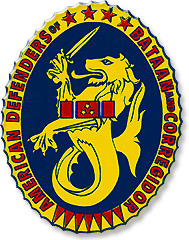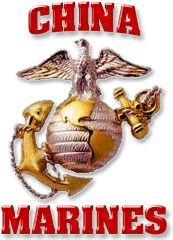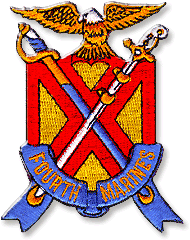

U.S. Marines Arriving in Shanghai
Aboard USS Chaumont, September 19, 1937
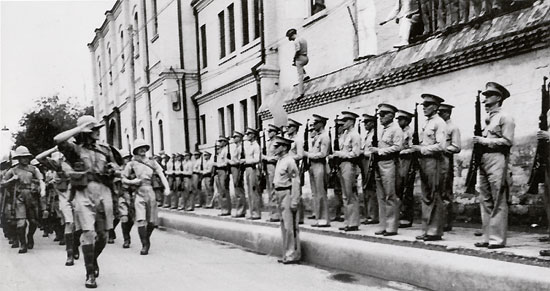

George Francis: Third from the
Right
|
Fourth Marines Regimental Flag:
"Old Blue" |
 |






|
U.S. Marines First Stationed in
China, 1927 |
 |
| |
 |
|
|
|
 |
|
China Duty 1927 - 1941
|
The 4th Regiment of the United States Marine Corps
received orders on January 28, 1927 to embark for expeditionary duty in
the Far East. This was the beginning of a 15 year tenure in China,
protecting lives and property of American citizens in the International
Settlement of Shanghai. The 4th Regiment never had to draw their weapons
although the Chinese Revolution and the second Sino-Japanese War were
within miles of the International Settlement.
The 4th Regiment had been called for service to protect American lives
and property because of the increasing political turmoil between Chiang
Kai-shek's National forces and the Communists. By April of 1927, the
crisis was over and Chiang Kai-shek's forces had control of Shanghai.
The International Settlement was not involved in the conflict and the
4th Marines began to settle into their surroundings. The regiment
changed its name on February 13, 1930, the regiment was officially
designated the 4th Marines, a change which applied to all regiments in
the Marine Corps.
Shanghai in 1842 was a sleepy provincial town, but the arrival of
Europeans began a remarkable commercial boom. By 1927 the city had a
population of about three million and it was the leading port of China.
The International Settlement consisted of British, Japanese, Italian,
Spanish, Portuguese, and Dutch communities. France also had an
independent concession just to the south of the Settlement. |
|
British
Band Members |
 |
|
Other nationalities included White Russians who had fled the Revolution
in their country twenty years earlier and there was also a thriving
community of Sikhs who had left India in the early thirties. Quite a few
Sikhs joined the Shanghai International Police Force and these men and
the 4th Marines helped each other out on numerous occasions. The
International Defense Scheme, indented to protect the Settlement against
Chinese attack, had been drawn up by the commanders of the British,
American and Japanese garrisons at Shanghai.
"There were American citizens over there which we protected, but most of
our duties were strictly guard. Standard Oil Company was over there and
we used to guard them. Then we had our own areas that we to guard. We
had to guard the hospital. The Navy Hospital. And so it was one day on
and two days off. The first thing you do is buy a teakwood chest. Then
you go down, you start buying this and buying that, whatever you could
afford. The ivory was the most important thing that we could buy. It was
real, real inexpensive there and you could buy like a Hamilton wrist
watch was like a Rolex today. You could get that for less than a hundred
dollars. Some silks, some kimonos, and just a little bit of everything
that you could. You just kept packing it and packing it and hopefully we
can get it home, you know. The 4th Marines had their our own club in
town, and, of course, everybody would go to the club. If you would
venture out to say, French town, there were several bars. Most of them
went to what they call the Green Hall Bar. It was a popular place that
everybody would go there. And it was just a regular beer place, you
know. So everybody would get drunk as a hoot owl. The French police is
the one that you really have to really be careful with, and if you got
caught by the French police. They would throw you in their jail and it's
like being thrown in jail in Mexico. You'd never get out of that place.
Boy, it's terrible. So you had to really be on your toes." - Pete George
It was choice duty. Among other things, labor, women, jewelry and other
items were available and cheap. Each squad could hire a Chinese man to
do all the work. Clean the room, make the beds, do the laundry, shine
shoes, and run errands. Billets and headquarters buildings were
converted schools, office buildings, or private mansions, rented from
their owners or the Shanghai Municipal Council. In April of 1938, the
past members of the 4th Marines gave the present marines a club all to
their own. On April 9th, the 4th Marines Club opened as the finest
enlisted men's club in the world. The club included a Noncommissioned
Officer's Bar, a Private's Bar, three lane bowling alley, billiards,
gymnasium, library, restaurant, movie theater, a ballroom, dining and
private rooms. |
|

|
|
Imperial Japanese
Army in Peking (Beijing), China - 1940 |
|
|
A new crisis began in September of 1931 when the invasion of Manchuria
marked the beginning of the Imperial Japanese efforts to conquer China.
The rise to power of Chiang Kai-shek worried the Japanese militarists,
who realized that the Nationalist drive to the north as a threat to
Japanese ambitions in Manchuria. Japan did not want a strong, unified
China.
On September 18, 1931, following a "staged explosion" by Japan on the
South Manchuria Railway, Japanese forces moved out from positions
guarding the track to occupy the principal southern Manchurian cities.
This invasion by Japan led a state of war between Japan and China and
also permitted the Japanese militarists to take control of the Japanese
government. On January 7, 1932, the United States stated it would not
recognize Japan's Manchurian conquest. Japan's answer was to proclaim
'independence' of Manchukuo under the puppet emperor, Henry Pu Yi.
Stuck right in the middle of all this was the 4th Marines stationed in
Shanghai at the International Settlement. The US was opposed to Japanese
aggression against China, but our garrison at Shanghai was a partner of
the Japanese and other powers in a plan to defend the International
Settlement against the Chinese. There was no provision for dealing with
a situation where one of the partners to the agreement attacked the
Chinese. The Japanese agreed to withdraw from the International
Settlement and the 4th Marines along with the British had no choice but
to remain neutral in the eminent war for Shanghai.
The 4th Marines turned to strengthen their defenses along Soochow Creek
to the north. On the other side of Soochow Creek was Chapei, the
location of the battle between China and Japan. By February 7th, 1932
the entire 3 ½ miles of front lines had been barb wired and sandbagged
with machine guns ready. The battle for Chapei lasted until March 3rd
and neither the Chinese nor the Japanese encroached on the International
Settlement but from their front lines, the 4th Marines had grandstand
seats for the war.
In 1937, the mascot of the 4th Marines arrived on the scene. Along the
banks of Soochow Creek, a small and underfed puppy began to post guard
along side other Marines. The men of the 4th Regiment began to help feed
the lost puppy and it wasn't long before he was taken back to live with
B Company. They named him Soochow and he became the mascot of the China
Marines. He was outfitted with three different uniforms; greens, khakis
and even dress blues. Soochow would hit the clubs and restaurants with
his fellow marines and on many Saturday nights, Soochow could be seen
riding in his own rickshaw back to his billet.
The second battle for Shanghai began on August 13th, 1937. Once again
north of Soochow Creek, the Chinese and Japanese were locked in combat.
Not until the final offensive launched by the hoarding Japanese Army in
October did the Chinese retreat from Shanghai.
The withdrawal of the Chinese army from Shanghai left the International
Settlement and the French Concession as two tiny islands of Western
authority in a hostile Japanese sea. The Allied numbers were sparse
compared to the Japanese army of 300,000, the British numbered 2,500 -
French numbered 4,000 and the 4th Marines numbered around 1,000.
Yet with even these small numbers, the International Settlement
continued business as usual. The Chinese post office, radio and
telegraph offices, and central bank all continued to operate within the
Settlement. The greedy Japanese were furious because they could not
control these institutions nor lay their hands on the rich revenues. A
new threat to the neutrality of the International Settlement came upon
on August 10, 1940, when the British announced the withdrawal of all
forces from Shanghai and North China. By the end of 1940, Admiral Thomas
C. Hart, commander of the Asiatic Fleet, was convinced that war with
Japan was inevitable. All but the 4th Marines and the Yangtze River
Patrol gunboats had departed by early 1941.
Japan's war machine moved southward in April 1939 with the seizure of
the Hainan Islands. That hostility combined with repeated bombings and
other atrocities against civilians in China, led to the move of the
United States Fleet from the West Coast to Pearl Harbor in May of 1940.
Japanese occupation of northern Indochina in August and her alliance
with Germany and Italy in the Tripartite Pact, on September 27th had
resulted in war material restrictions and to strategic conversations
among Americans, British, and Dutch concerning Pacific defense. When
Japan completed their Indochina occupation in July 1941, President
Roosevelt countered by freezing Japanese assets.
In Shanghai, the 4th Marines had been making plans in the event of
hostilities breaking out. Colonel Peck prepared a desperate escape plan
in case the Japanese attacked the International Settlement. Mounted in
all available motor vehicles, the 4th Marines were to break through the
roads blocks on the Settlement boundary and drive west towards territory
controlled by Chiang Kai-shek. Peck intended to keep the 4th Marines
together as a military force as long as possible. But, "when the
regiment hit something it couldn't crack," the men were to be instructed
to break into small groups and attempt to make their way as best they
could to the nearest Nationalist-held territory and then to Chungking,
some 900 miles away.
"The Japanese would just test you and see what you would do. They would
come on into our settlement, and, of course, what we would do is just
force them back out again. And I think two occasions we got into gunfire
with them. It was not in our end of the field but First Battalion, they
ran into it. They had a gun fight with the Japanese. Most of it, see,
was down towards where the harbor was. The Japanese were down in there
with their destroyers and light cruisers so they had a lot of run-ins
down there. They thought that they could just come on in and do it, and,
of course, we had orders that if they come into your sector, well,
you're to put them out, or, if not, then you get into a gun fight with
them so that happened a few times. The Japanese would capture the
Chinese people and would execute them every other day at 5 o'clock in
the afternoon. These were the Communist Chinese. Now, Chiang Kai-shek
was down in Chungking, but it was the communist regime that actually
took over China. It was Mao and his group that we would catch and then
turn them over to the Japanese. We watched a lot of killings over
there." - Pete George
The summer months passed with only minor skirmishes and Colonel Samuel
L. Howard, commanding officer since May 14, 1941, gained permission for
withdrawal of the regiment in early November. The liners President
Harrison and President Madison were charted for this purpose.
Thousands of cheering people waving Chinese and American flags lined the
streets to see the regiment, which had played such an intimate part in
community life for over 14 years, parade through the Settlement for the
last time. At the dock, members of the Municipal Council, the foreign
consuls and diplomatic representatives, the commanding officers of all
military units, including the Japanese, and the heads of many civic
organizations gathered to bid the Marines farewell. The 4th Marines
including Soochow were finished with Shanghai, their ships bound for the
Philippines. |







Shanghai Race Course and Park Hotel, Location of Grand Theater Sunday
Concerts















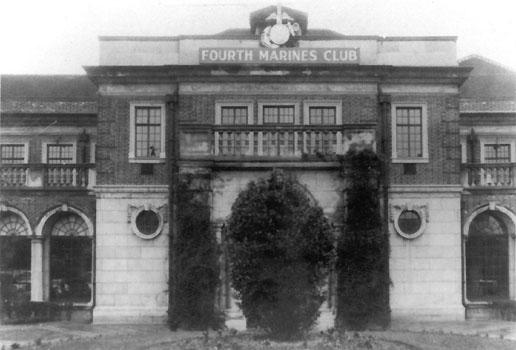






Catherine and Master Sergeant
August "Gus" Olaquez, Band Master












Commander of Japanese Guard in
Shanghai Bids Farwell to Col Samuel L. Howard and the 4th Marines Regiment,
November 28, 1941






|
